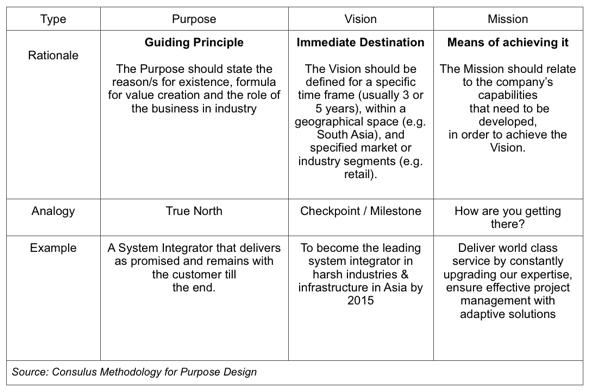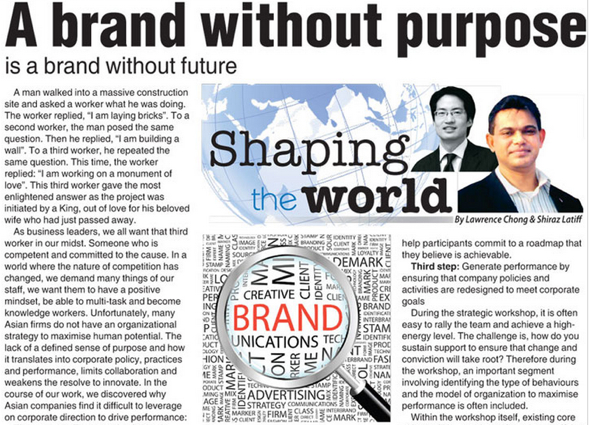A man walked into a massive construction site and asked a worker what he was doing. The worker replied, “I am laying bricks”. To a second worker, the man posed the same question. Then he replied, “I am building a wall”. To a third worker, he repeated the same question. This time, the worker replied: “I am working on a monument of love”. This third worker gave the most enlightened answer as the project was initiated by a King, out of love for his beloved wife who had just passed away.
As business leaders, we all want that third worker in our midst. Someone who is competent and committed to the cause. In a world where the nature of competition has changed, we demand many things of our staff, we want them to have a positive mindset, be able to multi-task and become knowledge workers. Unfortunately, many Asian firms do not have an organisational strategy to maximise human potential. The lack of a defined sense of purpose and how it translates into corporate policy, practices and performance, limits collaboration and weakens the resolve to innovate. In the course of our work, we discovered why Asian companies find it difficult to leverage on corporate direction to drive performance:
1st reason: The lack of definition in corporate direction prevents commitment
Most Asian firms have vision and mission statements but lack concrete processes to educate staff about their meaning and how this further translates into business initiatives. This makes it difficult to retain talents as they are unsure of the actual long-term goals of the company. This also creates problem among decision makers as not all of them have clearly defined interpretations of the company’s vision and mission, resulting in constant debates about the direction of the firm. Soon, without a sustained process of reviewing, clarifying and implementing relevant actions, people forget about these statements, giving rise to the perception of a lack of direction.
2nd reason: The lack of substantive assessment results in unrealistic strategic goals thus limiting business impact
Another reason why some corporate goals have been deemed as ineffective, is due to the fact that they appeared instantly. Many companies have similar sounding vision and mission statements that are aspirational and developed in a hurry. In a number of Asian nations, it is quite popular to ask a consultant to conjure up an instant vision and mission statement so as to qualify for a business award. But these instant statements, lack the familiar terms or context for staff to understand and connect with. At the end of the day, such statements have to provide a sensible goal for staff to work towards. As most staff are already skeptical of such statements, it is very important to find a way to make them realistic. Therefore, if they are perceived as irrelevant, staff tends to ignore them, defeating the purpose of having them in the first place as a means to inspire performance.
3rd reason: The lack of a comprehensive organisational system results in zero performance
The most likely reason why most organisations fail to profit after defining its direction, is the lack of an organisational system to inculcate beliefs and shape behaviors accordingly. After a corporate direction has been set, most companies lack the follow-up of assigning it to a senior person and team to oversee recommendations, schedule reviews, encourage practices and constant communication. When management lack the will to sustain communication and demonstrate commitment to the said direction, the company ends up rudderless again.
These reasons demonstrate that if Asian brands were to simply adopt a new corporate direction without a comprehensive process to implement them, then they will not derive any value out of it . The following are 3 steps on how to identify a unique purpose and implement a comprehensive system to achieve business success:
1st step: Find an enduring purpose from the inside-out
There is no short-cut in defining a corporate direction for the business. This is almost like the DNA of the company or the compass so as to guide all plans and initiatives. Prior to defining the vision and mission of the company, we found that it is important to identify the purpose, the reason of existence for the company. Once a company’s purpose has been clearly defined, it will be easier to set the vision and mission statements. Here is a table illustrating the different roles for the 3 type of statements:

As an organisation is usually a complex labyrinth of belief and practices, it is important to thoroughly assess the company before proposing such statements. A properly derived purpose statement that reflect internal beliefs will ensure buy-in and business returns from such an exercise. The purpose for such an extended study is to ensure that any statement will be believable and can be embraced by the staff. In our proprietary approach called the 3-state, we review the following aspects to identify an organisation’s unique purpose:
Ability: Definition of a Brand’s Capability in terms of the skills of the staff and production capabilities.
Influence: Definition of a Brand’s Credibility in terms of organisational culture and beliefs that resonate with customers.
Differentiation: Definition of a Brand’s Uniqueness in terms of innovation and unique experiences.
Based on these 3 aspects, we are able to identify in a realistic way, where the brand is and what it can be. From there, 2 probable tracks with regards to a unique purpose model will then be proposed.
2nd step: Secure the participation of stakeholders that represent diverse departments to ensure buy-in
With the relevant insights and results, it is necessary to gather senior and middle management from diverse departments. The research findings will provide the framework to reconcile viewpoints and align strategic plans. Usually a three-day event offsite is important so that everyone will realise how important this is.
The purpose of such a workshop is not to simply choose the path as proposed by the consultants. We often see these events as rare opportunities for insiders to passionately debate the future of their firm. Many staff are deeply appreciative of such opportunities and many a times their enthusiasm contributed greatly to the quality of debate. Insiders also know best so when they see the research findings, it is often a reflection of their concerns. But problems will always be there, what matters more will be the solutions. So during a strategic session such as this, we commit 70% of the programme towards identifying solutions while we provide the frameworks to set the stage for change to take hold. During such a session, other than identifying the purpose of the company, we help participants commit to a roadmap that they believe is achievable.
3rd step: Generate performance by ensuring that company policies and activities are redesigned to meet corporate goals
During the strategic workshop, it is often easy to rally the team and achieve a high-energy level. The challenge is, how do you sustain support to ensure that change and conviction will take root? Therefore during the workshop, an important segment involving identifying the type of behaviours and the model of organisation to maximise performance is often included.
Within the workshop itself, existing core values will have to be reviewed to see if they fit the new organisational goals. For example if the organisation decides to move from manufacturing towards more innovation, then its new core value should include an aspect to tolerate failures and encourage cross-department collaboration. And if the organisation has been used to working in silos, then it will be important to redesign department goals and performance measurements to include the element of collaboration. At the end of the day, the workshop must be able to produce a roadmap to ensure that the organisation will build on these beliefs and actually shape behaviors by redesigning policies and organisational models. To ensure that the new purpose model will be adopted and bring about business results, we apply another proprietary approach call the 6Ps to see this through:
i. Plans – Extent and sophistication of documentary proof that the idea is important. E.g The strategy plans as a result of the Purpose Design Workshop, commitment timeframes, accessibility of information.
ii. Persons – Hierarchy of the person driving the idea and the head-count behind it. E.g. Unique positions such as Head of design or Chief Innovation Officer, size of workforce.
iii. Process – Depth and wholesomeness of the eco-system of workflow that surrounds it. E.g. Process documents, checks and balances.
iv. Practices – Extent of natural iteration of rituals and level of participation from the community. E.g. Unique rituals or community habits as a result of beliefs.
v. Propaganda – Frequency and sophistication of communicating the idea/concept. E.g. Presence of unique vocabulary & symbology, communication channels ,frequency and curriculum.
vi. Performance – Assessment and relevant reward schemes E.g. Presence of measurement tools for the purpose of rewarding or encouraging similar behavior.
Through this process, there is a high chance of ensuring the growth of staff who believe strongly in the brand’s unique purpose as they are clear about its relevance to business and the associated rewards. A system designed in this way will surely transform the organisation and help to secure its future.
Lawrence Chong is the CEO of Consulus, a company specialising in helping Asian firms rebrand and redesign their organisations to be more innovative through business design. Consulus serve leaders in Sri Lanka in partnership with Shiraz Latiff, Chairman of Hummingbird International.




